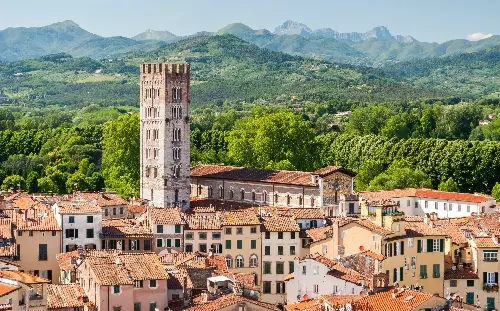
Most British tourists think they know Tuscany. And yet, most of them haven’t been to – or even heard of – the Lunigiana. Few tourists of any stripe have, in fact, which is one of the joys of this small but magical region.
It’s a different Tuscany – different heritage, customs, dialects and gastronomy – tucked into the region’s northernmost corner, bisected by the River Magra and caught between the Apuan Alps to the south (where Carrara marble originates from), the Apennines to the east and the Ligurian Riviera to the west.
Now a quiet backwater, the Lunigiana was once a hotly disputed territory, and castles still dot the region as a testament to its embattled past. In the 13th century, the noble Malaspina family held sway here: their castles at Fosdinovo and Monti are both well worth a visit. As is Piagnaro Castle in Pontremoli (which also has an exceptionally beautiful Baroque cathedral), where a fascinating collection of sandstone stele statues (human figures carved in abstract form in prehistoric times), are displayed in a special museum.
Given its name, I was expecting a lunar landscape. Not a bit of it: the word Lunigiana is reputedly derived from the particular way the moon is framed by the white-peaked mountains. Far from arid, it’s a place of valleys, rivers, streams, and steep hills clothed in chestnut forests.
Follow one of the region’s twisting roads and you’ll arrive at one of its sleepy villages, although many of them have been depopulated in recent years. In spring, the roadsides and hillsides are dense with wildflowers, including orchids and poppies; in early summer, the dancing, yellow-green glow of fireflies are a night-time spectacle, while day-time heat is often fanned by a cooling mountain breeze.
Food festivals around this time include the onion festival in Treschietto, where the local white-fleshed, red-skinned onions are served in various culinary guises. In autumn, meanwhile, season of the all-important chestnut harvest, mushrooms and truffles are also unearthed in the woods and the colours turn from various shades of green to aubergine and amber.
My most recent visit to Lunigiana was last autumn. For culture and a dose of Renaissance Tuscany, we made day trips (an hour away) to Pisa, Lucca and the five villages of the Cinque Terre (Monterosso al Mare, Vernazza, Corniglia, Manarola and Riomaggiore) on the coast. For the most part, though, we stayed put and – to be perfectly frank – ate.
In the Lunigiana, tradition, simple living and – crucially for most visitors – wonderful local cuisine are its best attributes. Testaroli (a thin, spongy type of pasta usually served with pesto sauce); torta d’erbe (green vegetables in a pastry crust); panigacci (small flatbreads); chestnut flour; chestnut honey; olive oil and local wine (lighter than the Super Tuscans and very drinkable): these are some of the highlights of the region.
Accommodation in such a hilly and relatively little visited area is somewhat limited: a handful of good hotels, some characterful agriturismi and a selection of rental villas. This time, a group of us (girls only), stayed at Villa Palma, a handsome 1920s villa, in tiny Gabbiana, with fine original tiled floors and stunning, uninterrupted views across the hills to the Apuan Alps from its pool.
The villa is owned by Christopher Brooke and his wife, the Radio 4 broadcaster Sarah Montague, who stumbled across the Lunigiana by chance not long ago: “It felt like Devon 40 years ago and it ticked all our boxes,” they say. “Tuscany but far less expensive and less obvious and yet easily accessible, just an hour from Pisa airport. Wonderful, varied walking and great food too.”
Here, nature and gastronomy are perfectly entwined. One day, for example, we went wild swimming in a rock pool near Comano, followed by a memorable lunch at Casa Turchetti, an impeccable, characterful agriturismo. Another day, we climbed to the hilltop castle at Bagnone, then rewarded ourselves with an amazing meal at the delightful, family-run Locanda da Lina.
The restaurant is located in a picturesque square in the village below the castle, and we tucked into three perfect courses, including fresh truffle pasta, for just £15 per person.
On another day, we walked along the forest path that connects the two ancient, almost silent stone villages, Camporaghena and Torsana, passing by a lovely waterfall and an old mill on the way. During the Second World War there was heavy fighting throughout Lunigiana and in Camporaghena’s piazza, a moving tribute pays homage to Don Lino Baldini, who was executed by the Nazis in 1944 for ringing the church bells to warn the villagers of an impending Nazi reprisal.
We also walked on the Via Francigena, the pilgrim route from Canterbury to Rome. Our reward that day was a simple but excellent set lunch in a restaurant packed with local workers (always a good sign): Venelia in the village of Monti.
Though no distance in the Lunigiana is great, the hilly winding roads mean that it takes longer to get about than on the larger white roads that criss-cross the rest of the province. But therein lies an insistence that you take things slowly – and really, isn’t that what a visit to glorious, languid, fragrant Tuscany is all about?
Essentials
Easyjet flies from various UK airports to Pisa from £22 one-way. Villa Palma in Gabbiana sleeps up to 10 people in five bedrooms with four bathrooms and costs from £3,500 per week.
Agriturismo Casa Turchetti, in Comano, is run by a young couple, Federico and Silvia and is set in a beautiful former oratory. There are four double rooms, two apartments and a pool and Federico’s excellent cooking is served on the terrace or in an atmospheric old dining room. Doubles £185 per night.
Castello di Pontebosio, near Licciana Nardi, is located on the banks of the River Tavarone. The hotel and spa is set in an immaculately restored 17th-century fortified manor. Doubles from £180.